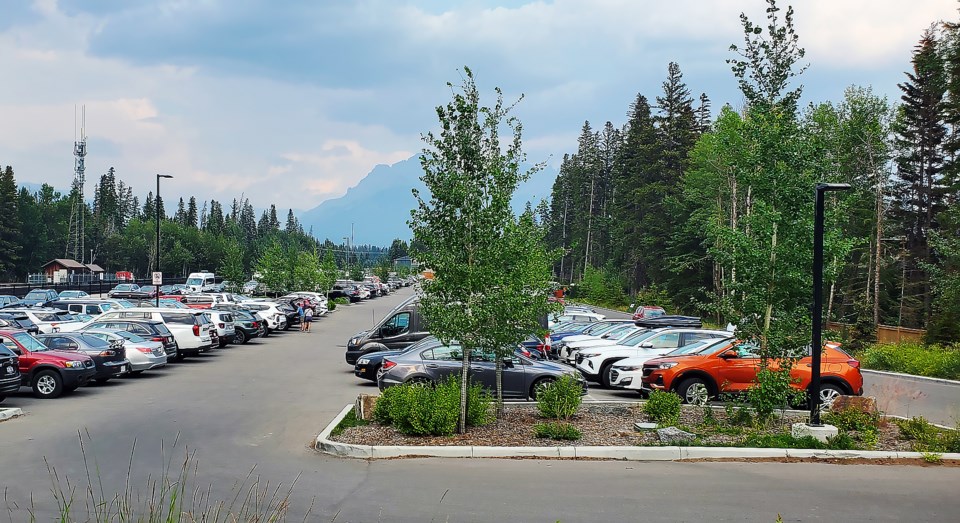BANFF – Banff’s elected officials have done a sharp U-turn on their ongoing push against Parks Canada for an intercept parking lot outside the townsite boundary to deal with the tourist town’s congestion woes.
Council is reallocating $30,000 previously budgeted to study the feasibility of a land swap with Parks Canada for a park-and-ride lot outside the town boundary to now look at options for a parkade or surface lot at the east entrance inside the municipality’s four sq-km boundary.
“I have always supported the creation of an east side intercept parking lot and I think it is an essential part of solving our congestion issues,” said Coun. Grant Canning, who made the initial pitch to explore a potential land swap with Parks Canada more than a year ago.
“But it’s become apparent we needed to refocus our attention on locations we control. … Clearly, anything outside of our boundary we don’t have control over, and I would even argue we have very little influence, let alone control.”
The Town of Banff has long eyed the Elkwoods area outside the boundary for an intercept parking lot, but Parks Canada has consistently said no to land outside the town in the rare montane for more than 20 years.
There is also a critical wildlife corridor in the area.
No land inside the townsite has been identified yet, but one of the most likely areas could be the industrial compound, including the contaminated 1.5-acre off-leash dog park on Hawk Avenue, part of which was a former dumping ground of Canadian Pacific Railway in the 1960s.
The municipality also has land on the east side of Banff Avenue on the Tatanga benchlands, which is currently being eyed for a potential 250-unit affordable housing development as the Town looks to deal with its housing shortage of between 700-1,000 units.
Darren Enns, director of planning and environment for the Town of Banff, said any land for an intercept parking lot is likely competing for housing.
“Whether it’s parking or housing, land is king, and that is our primary constraint right now,” he said.
“Looking within the town boundary adds an additional layer of complexity and will likely result in solutions that are sub-optimal from a parking perspective.”
Enns said the study will be high-level, looking at capacity, yield, efficacy and connectivity to town.
“That’s the kind of analysis we would produce, a very high level schematic of multiple sites,” he said, “We understand this would include both surface and structure parking.”
The Parks Canada-struck expert panel on moving people sustainably in Banff National Park recommended intercept lots and transportation hubs to deal with traffic troubles. Parks Canada has committed to delivering a sustainable strategy for moving people by 2026.
Mayor Corrie DiManno said council needs to look at an east side intercept lot sooner rather than later to deal with congestion in town given Parks Canada’s 2026 timelines.
“I don’t love the idea of having to prioritize parking over any kind of potential housing site or park area, but we certainly need to move forward on this because we know that intercepting vehicles on the edge of town is a successful model for us,” she said.
“This summer, we saw folks parking in really awkward, kooky spots … the reality is on a summer day, there’s nowhere to park after 10 a.m.”
Canning said the Elkwoods location is much preferred for a host of reasons, but added council has waited too long for Parks Canada to come forward with solutions that have never materialized.
“Obviously it would make sense that we change gears and we look at the possibility of doing it within our existing town boundary,” he said.
“As difficult as it can be sometimes, good shouldn’t be the enemy of perfect … these locations would be sub-optimal, but we’re at a point where all the options have to be on the table.”
Canning said it’s important to keep in mind that dealing with congestion needs to be a holistic approach, which started with Roam transit, visitor paid parking and the residential parking permit system.
He said fare-free transit for residents on local Roam routes proved successful with more than 400,000 rider trips in 2023 and council is now looking at universal fare-free transit to include tourists as well on local routes.
“This idea of an east intercept lot is really the last big component that we do directly control,” said Canning.
“The focus of it for me has been the absolute need to get people out of their vehicles before they come into the town.”
Administration will bring the high level report back to council no later than 2025 service review at the end of the year.




